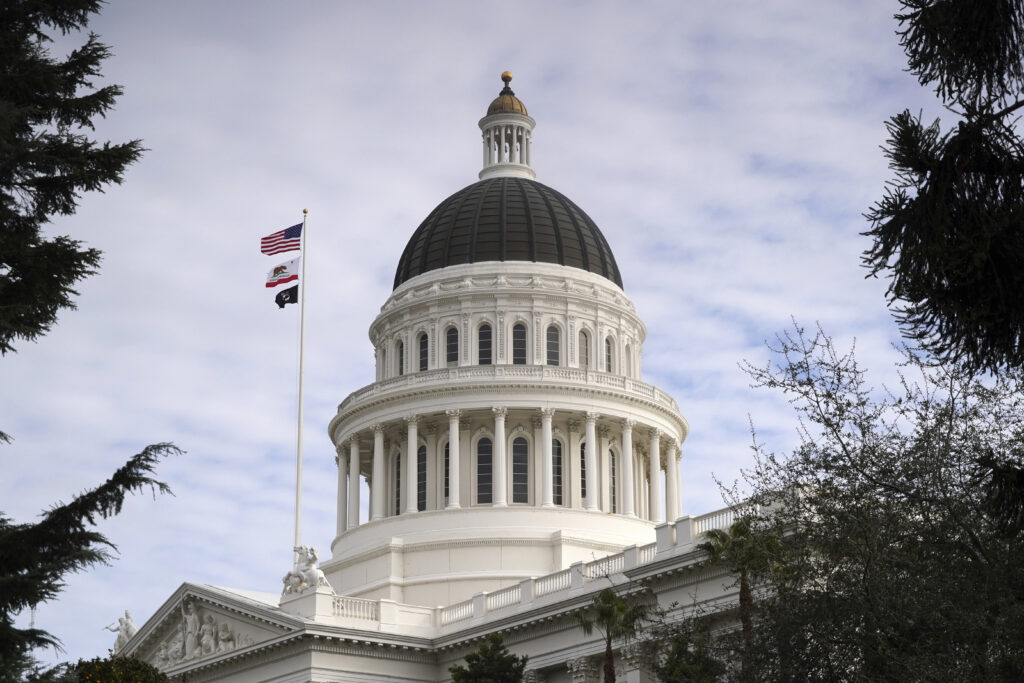
After years of preparation inside and outside the state Capitol (shown), California has launched a website that gathers all sorts of education and career data in a single, searchable place.
Credit: Kirby Lee / AP
Top Takeaways
- The Cradle-to-Career data system links education, workforce and social service data.
- The Student Pathways dashboard, released Tuesday, will help students decide on a college and career path.
- California is one of the few states that make educational data easily accessible to the public.
California introduced the first phase of its ambitious Cradle-to-Career data system Tuesday, making it one of the few states with education data accessible to everyone.
Now, parents, students and others can go to the Cradle-to-Career (C2C) website to learn how many graduates from each school district earned a bachelor’s degree each year, how long it took to achieve that goal and how much, on average, they earned after graduation.
Cradle-to-Career links data sets from school districts, institutions of higher education, workforce organizations and social services to help students plan their education and careers.
The first phase, the Student Pathways dashboard, explores pathways to and through college, college enrollment, awards and diplomas, time to graduation or certificate, and earnings during and after college.
“With the C2C Student Pathways Dashboard now live, Californians can visualize their futures by seeing disconnected data from across sectors and previously unavailable insights, all in one place,” said Gov. Gavin Newsom in a statement released Tuesday. “The Golden State is once again leading the way in innovation, connecting our education system to the workforce to ensure everyone has the freedom to succeed.”
How it works
The website uses charts, guiding questions and pull-down menus to make the information accessible and easy to use. The pull-down menus allow users to compare their child’s school to other schools, the state average or legislative districts. They can also compare the pathway progress of different student populations, said Ryan Estrellado, director of data programs for C2C.
Each chart in the dashboard has links with instructions to help users interpret it, and includes links to underlying data that can be downloaded and used by the public to create their own charts and reports.
“What’s so exciting about what California has done is they’re putting the information out to everybody,” said Paige Kowalski, vice president of the Data Quality Campaign, a national nonprofit advocacy organization. “It’s out there for the community folks, for schools, for parents, for kids looking at colleges. And, this is their first step, right? It’s not everything. It’s not all of it, but it is the first step, and it’s a really good one.”
Future C2C dashboards will focus on early education, primary school, college and career readiness, transfer outcomes, financial aid, employment outcomes, and teacher training and retention.
This year, the data team will work on launching additional dashboards and completing a secure data enclave to allow researchers to use underlying data, said Mary Ann Bates, executive director of C2C.
Access to centralized data about education and workforce outcomes is necessary to understand whether efforts to improve student success are working, according to a media release from C2C. The dashboards will not include information about individual students.
A community effort
The website follows years of community meetings, open meetings of the 21-member C2C board and feedback from residents, advocates, policymakers and researchers. The most requested feature from the public, Bates said, allows users to break down the data by both geography and student populations.
“We hope that when the public uses this, they will see that the questions and the feedback that they had are represented here,” Estrellado said Monday. “The most exciting part for me is that we invite them to continue that conversation with us as we improve this tool. I can’t wait to get it to the public.”
C2C data will eventually be available in three ways — through accessible data stories and charts, through aggregated data files that use query builders, and through a data request process for approved research projects.
Launch delayed
The initial launch was originally expected to happen late last year.
“We prioritize securing the data system, ensuring privacy protection and ensuring linked information is accurate and reliable before working to make our tools publicly available,” said Bates when asked about the delay.
The data for the website is submitted each March by partners that have signed data-sharing agreements with C2C, including the California Department of Education, California Commission on Teacher Credentialing, University of California, California State University, California Community Colleges, Department of Social Services, Employment Development Department, Department of Industrial Relations, Department of Developmental Services and private universities.
The data from all partners was linked by the end of the year, Bates said.
“We’re really proud of being able to have moved from the linkage of the underlying data system to releasing a public tool just a few months later,” Bates said. “Few (states) have prioritized creating dashboards like this for the public. And many of those have done so after more than a decade of working on building their data systems.”
Six years in the making
In 2019, the Legislature passed the Cradle-to-Career Data System Act, which called for creating a data system to support teachers, parents and students; enable agencies to optimize educational, workplace and health and human services programs; streamline financial aid administration, and advance research.
The state legislation included public engagement in the planning process and mandated that the data system also require an annual survey of students and their families to ensure their voices and experiences guide the work, according to C2C. By the end of 2023, the program had received its first batch of data.
The price tag for the project, which includes direct costs like contracts, as well as relevant staff time, is $24.2 million, Bates said, and current spending is still below that.
There is also an ongoing line item in the state budget to fund the operation of the office and to pay the salaries of its staff, including $15 million this fiscal year.
Federal cuts to education data collection are not expected to impact the Cradle-to-Career IT project, which is entirely funded by California. It is not clear if data collection from any of the state’s data partners will be negatively impacted by federal cuts.
“Regardless of what happens in the federal context, we remain committed to ensuring that we’re building a data system that answers the needs of Californians and remains true to California’s values,” Bates said.
Kowalski is hopeful that the work California has done can be replicated in other states.
It took a great deal of political will, resources and expertise to make the California data system a reality, Kowalski said.
“Data tells us what kind of job we’re doing, how we fared as a political leader, as an agency head, as a system leader,” Kowalski said.
“And when you put that data out there, whether you’re sharing it with another agency, or you’re putting it out in the public, or you’re handing it over to a researcher, you are giving them the power to look at that data and judge you.”
 VIPRE Security Group, a global leader and award-winning cybersecurity, privacy, and data protection company, today announced the launch of its new VIPRE Integrated Email Security (IES) Solution.
VIPRE Security Group, a global leader and award-winning cybersecurity, privacy, and data protection company, today announced the launch of its new VIPRE Integrated Email Security (IES) Solution. 




